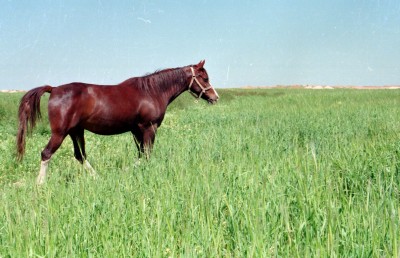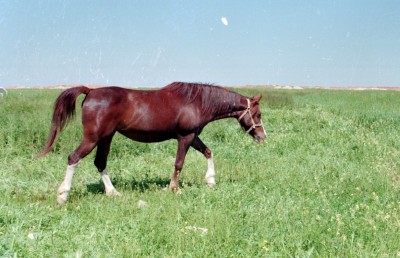Kuhaylah Hayfiyah mare, Syria
This is a Kuhaylah Hayfiyah at the stud of the late Alaa Din Jabri (Mustafa’s uncle), east of Aleppo. I forgot what her name was, but you can easily find her in the first Volume of the Syrian studbook. Her sire was Mahrous, and her dam one of the two bay Kuhaylah Hayifiyah mares daughters of the Saqlawi Marzakani stallion Ghuzayyil (there were two of these back in 1992 when I took that picture, a younger one and an older one). This mare was very pretty and very strongly built at the same time. Certainly one of the best Mahrous daughters.
Alaa Din Jabri bred this line for at least four decades, and before that time the line was with Wawi al-Kharfan of the Fad’aan Bedouins. It is said the line is somehow related to the horses of the last of the leader of the Fad’aan Bedouins to live in Syria: Miqhim Ibn Mhayd.
In any case, the strain of Kuhaylan al-Hayfi belongs to the leading Mhayd clan of the Shumaylat section of the Fad’aan Bedouins, as I mentioned earlier on this site, here. This is where the Hayfiyah mare *Reshan came from. She was imported by Homer Davenport to the USA in 1906, and was bred by Ibn Hubayqan of the Shumaylat.
That said, when samples from the two lines were recently compared by the UC Davis lab with the help of Michael Bowling, the mtDNA haplotypes from this line of Alaa Din Jabri’s and from that of the *Reshan line did not match. Not sure why. Not sure how it matters, either. Or whether it does at all in this case.


I love this mare. She looks so much like Monsoon’s full sister, Fancy Flight (Tripoli x Ceres). The color is even correct, right down to the dark colors in the mane. We would have been proud to have this mare in our pasture!
Funny you should say that Jeanne as I looked at the picture I thought she looked a lovely mare … beautiful and useful, and the image of Monsoon came to mind.
She is also VERY like a mare I have on breeding loan at the moment Crabbet (high %)Egyptian/Davenport/ Polish (I know… NOT Asil but as ‘Arab’ as they come physically and in her wonderful character).
While the breeds re in many ways very different indeed, people here say a good Welsh Cob should have a ‘head like a ladies maid and an arse like a cook’, it sort of reminded me of that too.. as Eduoard said strong and beautiful 🙂
Edouard,
At this point as to more complete testing, I agree it does not really matter. However, If all these testings are not continued, answers become more serious. Now, we know that Reshan’s blood goes into another tail female line. (by strain) But just where do these mares here presented go? What is serious is not all the past naming of strains, but, perhaps, the renaming to tail female DNA.
Will DNA in time become the standard as to each mare line? I think so, and the first tail female known will become the strain. Does not matter the strain once thought, what matters is the knowledge learned from the tail female’s DNA. Especially, where understanding the mind set of the Bedouin. All they, the Bedouin, claimed was to being Bedouin bred in purity. Same as we today. In the sense of importance, knowing the DNA as to the desert and the Bedouin, I agree is not important.
No importance? What is important, is, what happened after the departure. This is the truth we all as breeders need to remain secure in.
Strains can then be known by their breeders, and the quality of that breeders efforts. (Like Craver Farm.)
There are many farms outside the original desert breedings. Just as many differing imports to those farms.
A standard needs to be sought by all and it now seems to be the DNA standard.
Jackson Bedouin Arabians
As to the mare, she looks to be a really good individual!
What a fine photo you took.
Jackson
According to your indications the mare is “Zouhour” 1987. #344 in Syrian SB
Mahrous x Durrah
Durrah is by a Kuheilan Krush a son of Ghuzeil
Durrah dam is Freihat
Freihat is by the same Kuheilan Krush(than above) and a Kuhailah Haifieh from Wadi Kharfan.it seems that she left no progeny.
Durrah was very prolific .she produced a beutiful mare by Abjar named “Al Sajeda” that I tried ,in vain,to buy at any price for our “Al Fadi Stables”.Omar Anbarji was the intermediary.
“Abjar” a Saklawi Jadrani Ibn Zobeini, one of Syria’s best stallions, is inbred to “Guzeil”.
“Al Sajeda” has 4 lines to Guzeil and I was looking for a mare with “Moje al Atheer” or “Guzeil” lines in order to mate them with my “Hussam el Shamal” who also had these lines.
Exactly. This is Zohoor. I have several pictures of Al Sajeda.
the mtDNA haplotypes from this line of Alaa Din Jabri’s and from that of the *Reshan line did not match. Not sure why. Not sure how it matters, either. Or whether it does at all in this case.
This is just more evidence for the theory I remember being discussed in Paso Robles in 2007 and in Bend in 2009; that strain names originated in groups of mares under a single ownership, rather than a single mare and her daughters.
What a strain name denotes to me as a North American breeding Arabians in 2010 is authenticity, and a key into the origin and history of the dam line. Not conformational type, and not a specific mtDNA type, either.
Yes, a link to the culture that produced the Arabian horse.
well, just to repeat what I said in January on this blog: I have always felt that because this breed is called “Arabian” horse that ultimately it is the culture that defines the breed, not the science.
DNA is still an important story teller but mainly about specific relationships rather than about defining specific strains.
One must not forget ,that the strain recorded in a pedigree of the horses sold to the Western buyer is not always the real strain.
Robert Mauvy writethis: that the seller knowing from the guide/translator what strain the buyer was looking for could present any Asil horse to him saying that the horse was from this particular strain,this when the horse was Asil!Remember that they tried to sell to Davenport trough Ahmed Haffez,a high ranked Bedouin, a non Asil mare.
So imagine if Davenport was alone all by his self.
of course, which explain the comparatively high numbers of Saqlawi Jadran (the most fashionable strain to Westerners) sold to Europeans for Weil Babolna and other studs..
just a quick note as too busy. Zouhoor in still a life at Yakan farm
Omar Anbargi
May she live very long.. Does she have daughters? Is the line going on?
Where does this discussion go to? Can we rely on the origin of our horses if westerners buy horses in Arabia with false informations as false strains and so on? The preference of Weil for Saqlawi Jedran comes from the foundation stallion Bairactar and we have the expressive wish of the queen of Württemberg to look for horses of this strain given to Count Rzewuski when he undertook his mission into Arabia to buy horses.
Oral tradition as well as written studbooks can never be without mistakes, even if You care to avoid them. And also cheat can not be ruled out, but isn´t the credibility of the bedouins one of our main arguments to defend our Asil breeding principles?
Matthias
Was the mare that Davenport didn’t buy not asil, or was she not shubuw? Since he only used the term “chubby,” I am wondering.
Davenport apparently asked the Bedouin is she was “chubby” which is shubuw, in other words if stallions from her offspring could be mated within the tribe. The Bedouin owner said she was shubuw to Davenport but not to God.
Nobody was questioning the asil status of the mare.
Saying that she was “Shubbuw” to Davenport could also mean:”She is good enough to you Chritian foreigner.”
This is the way that they use to look at foreign buyers.
Being not “Shubuw” means that he was not certain of the mare origin:
1– she or her dam bieng taken in a ghazu or war,her rider being killed no one knew about her origin .the same mare in her original tribe could be “Shubuw”
2– She could be from a non-Asil line (“Shimali”or “Turkmen” dam line).this could be possible as the region was on the Mossul/Aleppo road where Merchants mounted on Turkmen horses used to bring goods from Northern Persia to Aleppo,moreover Membij being not far from Mesopotamia (Syrian Jezireh)where “Shimali” horses could be found until today.
3– Being not “Shubuw” could also mean that her line could have bring bad luck to her owner,or that one owner died in a ghazu and therefore be considerd “Not Shubuw” by this particular tribe and perfectly “Shubuw” by another.
One must not forget that the Bedouin is very superstitious and any bad sign on a horse could have a great importance .
To understand these signs, reading the last part of Carlo Guarmani’s book could be very instructive;it may serve in buying your next horse!
hello ,
she has no daughters , but she is pregnant now ,
Regards
Omar Anbargi
Al hamdu lillah. Omar, keep me informed please if/when she foals. Who was she bred to ?
sure , Sayf Al-Shemal , Kuhaylan Nawaqi by Ruba Al-Shemal ( Nawaqia ) and Mahboob Hisham ( Manaki Subayli )
Seif a Shemal is Hussam al Shemal maternal brother and Syrian National champion 2009
Hello,
Zouhoor is still alive and in good health, we are caring for her (special care) because of her age, now she’s pregnant from Saif Al-Shamal, Kuhaylan al-Nawaq.
Raed Yakan
Al-Shamal stud
We are all hopeful of a wonderful daughter to represent this mare!